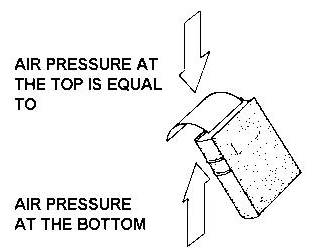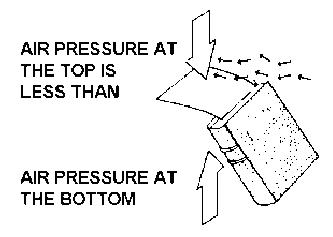DiscoverHover CURRICULUM GUIDE #8 - Experiment
© 2004 World Hovercraft Organization
PARTNER'S NAME
EXPERIMENT 8.1
Equipment:
2 thick books or binders
1 sheet of notebook paper
1 straw

Place two books or binders parallel to each other on a table
and approximately 3” [76.2 mm] apart. Place the sheet of paper over
the gap between the books, with the edges of the paper resting on the inside
edges of the books. Using the straw, blow underneath the paper as hard as
possible. The paper will be pushed down in the middle toward the table. The
increase in air speed underneath the paper causes a decrease in pressure.
The higher pressure on the top of the paper pushes the paper down toward the
table.
EXPERIMENT 8.2
Equipment:
Strip of notebook paper or newspaper, about 2" [50.8 mm] wide and 10" [254 mm] long
Book
Paper clips
The force that lifts an airplane and holds it up comes from air which is forced
apart by a moving wing.

Make an airfoil (wing) by placing one end of the strip of paper
between the pages of the book so that the other end hangs over the top as shown
in the above diagram. Move the book swiftly through the air or blow across the
top of the strip of paper. Notice that it flutters upward.
Hold the book in the breeze of an electric fan so the air blows
over the top of the paper and observe what happens.

Take the strip of paper out of the book. Grasp one end of the
paper and set it against your chin, just below your mouth. Hold it in place
with your thumb and blow over the top of the strip. The paper rises. Try the
same thing after you have fastened a paper clip on the end of the strip. See
how many paperclips you can lift in this way.
It doesn't matter whether you move the air over the strip of paper
by blowing or whether you move the paper rapidly through the air - either way
it rises. How does this relate to what causes the wings of aircraft to produce
lift?
EXPERIMENT 8.3
Equipment:
2 empty soft drink cans
30 or more plastic drinking straws
Another way to demonstrate Bernoulli’s principle is to lay
about 30 drinking straws parallel to each other on a tabletop, then place two
empty soft drink cans on top of the straws as shown in the picture. Using one
of the straws, blow as much air as you can between the two cans and watch what
happens. Get a partner with a second straw, and this time each blow along the
outside surface of each can. Can you explain why the cans move the way they
do?

www.shawsciencezone.com
EXPERIMENT 8.4
Equipment:
A long vacuum cleaner hose or other similar hose (at least 1" [25.4 mm]
in diameter)
Small bucket filled with sawdust or paper bits from a paper hole punch
This experiment will help to dramatically demonstrate Bernoulli's Principle,
but be forewarned -- it can make quite a mess! Place the bucket of sawdust/paper
scraps on the floor, with one end of the hose in the bucket. Keeping one end
of the hose in the bucket, swing the other end rapidly over your head like a
lasso. (Watch out for low hanging light fixtures!) The sawdust/paper scraps
will come shooting out the top of the hose!
When swinging the hose around over your head, the increased air speed at that
end of the hose results in a corresponding decrease in air pressure. This results
in the higher air pressure at the other end of the hose (the end in the bucket
of sawdust/paper scraps) pushing the paper through the hose and out the swinging
end!



